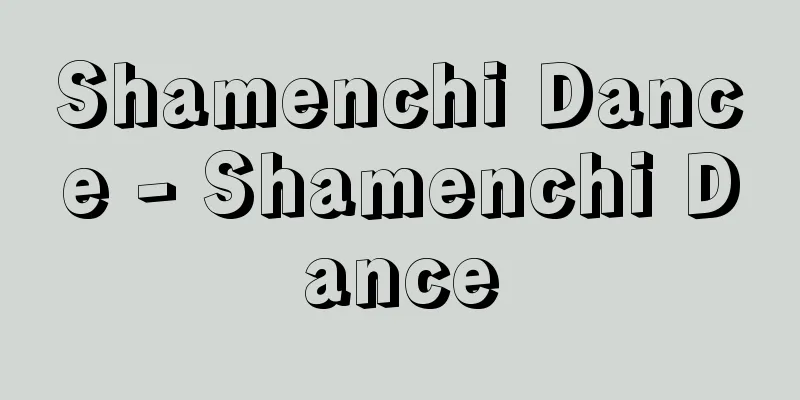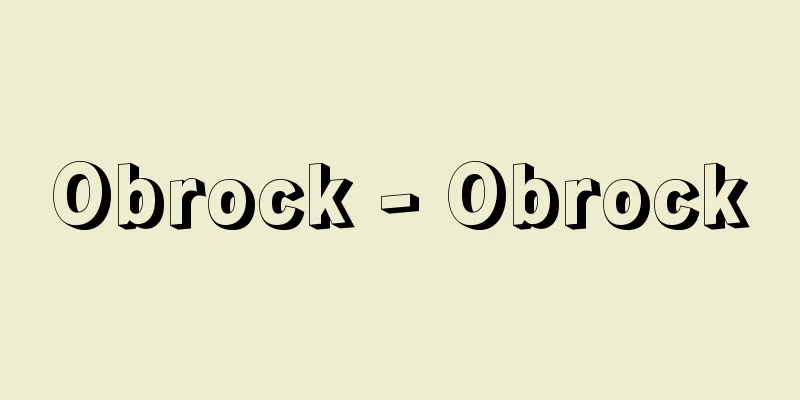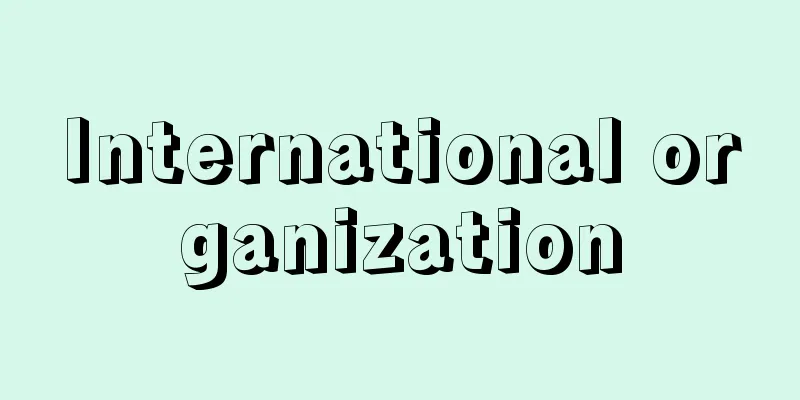Chinese - Chinese

|
A language mainly used by the Han people, mainly in mainland China and its surrounding areas. In the People's Republic of China, a multi-ethnic country that includes many ethnic minorities, it is officially called "Hanyu", meaning the language of the Han people. Some ethnic minorities also use Chinese, and it is also used by overseas Chinese in Southeast Asia, the United States, and other parts of the world, so the Chinese population is probably close to 1.4 billion, making it the language with the largest number of speakers in the world. [Hisao Hirayama] Lineage and historyChinese is said to belong to the Sino-Tibetan language family (Han-Tibetan language family) along with Thai, Miao, Tibetan, Burmese, etc., but this is merely a conjecture based on typological commonalities such as monosyllabicity, isolating nature, and the presence of tones, as well as the similarity of the word forms of a very small number of words, and strict academic proof based on phonological correspondence has not yet been achieved. Even if Chinese is related to these languages by lineage, it is thought that it separated from them very anciently (probably more than 5000 years ago). Records of the Chinese language began with the oracle bone script of the Yin dynasty (13th to 11th centuries BC), and a wealth of Chinese documents (many of which were published after being handed down as manuscripts) have been preserved throughout the various periods since the Zhou dynasty. The language found in pre-Qin books such as the Analects was relatively close to colloquial language, but after the Han dynasty it became a classical literary language, and although there were some differences in style depending on the era, it was basically handed down as the official written language until the beginning of the 20th century. On the other hand, there are documents such as the Shishuo Xinyu (a collection of anecdotes from the 5th century) that contain a fair amount of colloquial language of the time within the literary language, and from the 10th century onwards, documents that use mainly colloquial language like the sayings of Zen monks (collections of questions and answers) and vernacular novels such as the Water Margin appeared, giving us a glimpse into the actual state of Chinese language in each era. Based on these documents, the history of Chinese can be roughly divided into the following categories (almost following the classification in Wang Li's Draft History of the Chinese Language): (1) ancient (13th BC to 3rd century AD), (2) medieval (4th to 12th century), (3) early modern (13th to early 20th century), and (4) modern (after the May Fourth Movement of 1919). In terms of phonetics, the main nodes are the "Ancient Phonetic" estimated based on the study of the rhymes in the poems of the Book of Songs and the phonetic symbols of phono-semantic characters, the "Middle Eastern Phonetic" estimated based on the Sui dynasty rhyme book (a pronunciation dictionary for composing poetry) Qiyun, the "Modern Phonetic" estimated from the Yuan dynasty rhyme book Zhongyuan Phonetic, and the modern standard phonetic (Beijing phonetic). [1] Ancient languages have many monosyllabic words and are strongly isolating, but on the other hand, there are also inflected derivations such as consonant alternations such as "see" * kiän (to see) → * g'iän (to be seen, to appear) and tone alternations such as "general" * tsiang (to lead) → * tsiang (one who leads, general). When an interrogative pronoun or a pronoun in a negative sentence is the object, such as in "Ware dare wo ka zam kan" (Ware who I deceive) or "Ware wo shirazu" (Ware wo shirazu), it is placed before the verb, and "I" is often used in the subjective and possessive cases of first-person pronouns, and "wa" is often used in the objective case (after the verb). Another characteristic of "Old Phone" that is not found in later generations is that it has double consonants such as * kl-, * pl- and voiceless nasal consonants such as ,. [2] In medieval Japanese, the pronoun "kore" (this) changed into a "connective" (keishi) indicating the subject-predicate relationship, the noun predicate sentence (A is B) changed from "A, B ya" in ancient Japanese to "A ye B," the third person pronouns (such as "i," "qu," "ta") and noun plural endings (such as "to," "hai") appeared, classifiers (such as "mai," "ko," "hi," "to") were added to count nouns (as in "one horse"), and compound verb forms were developed, making it easier to express actions analytically. Many modern common words such as "ha" (this), "shi" (what), and "ki" (eat) appeared during this period. The use of the noun ending "zi" (child) (such as "chair" and "hat") also became widespread during the Tang Dynasty. "Middle English" had an even more complex structure, with four series of initial consonants (initial consonants) at syllables: clear consonants (voiceless unaspirated consonants such as p, t, k, ts), subsequent clear consonants (voiceless aspirated consonants such as p', t', k', ts'), voiced consonants (voiced consonants such as b, d, g, dz), and subsequent voiced consonants (nasals, liquids, and weak fricatives such as m, n, l, j). Syllable-final consonants (finals) included m, n, ŋ, p, t, and k in addition to i and u. There were also a large number of central vowels, and there were four types of tones (four tones): pingsheng, shangsheng, qisheng, and enteringsheng. [3] Early modern Japanese, while inheriting the innovations that appeared in medieval Japanese, added new features such as the establishment of verb endings "le" (completion), "chaku" (duration), and "ki" (start) to indicate the voice of the verb, and the increased use of the inclusive form of the first person pronoun "咱 (喒)" (we), the non-inclusive form "ore" (ore), and the noun ending "兒". In "early modern Japanese", all voiced consonants merge into all clear consonants or next clear consonants, the onset voice disappears or is weakened, and the number of central vowels is reduced, resulting in a simplification of the pronunciation system and a close approximation to the pronunciation system of modern standard Japanese. [4] Modern language was developed on the basis of modern languages, adding vocabulary and expressions that correspond to modern concepts and things, as well as socialist ideas and systems. Colloquial writing became the official style, and the writing styles of famous authors such as Lu Xun and Mao Zedong influenced colloquial language. While Western speaking styles were adopted and precise expressions were used, it is said that colloquial expressions have become stiff in recent years. [Hisao Hirayama] Dialects and Standard LanguageHistorically, the areas where Chinese is spoken expanded from the original Yellow River basin to the surrounding areas, especially southward, following the development of the Han people, and during this time differences in dialects became evident. "Dialects," written by Yang Xiong of the Western Han Dynasty, is a book that compares the vocabulary of the major dialect regions of the time. In the Southern Dynasty of the Six Dynasties period, the indigenous southern dialect and the northern dialect brought from the north by the ruling class were spoken side by side. The countless dialects that exist in modern Chinese can be broadly divided into the following five groups based on their phonetic and lexical characteristics. [1] Northern dialect (Mandarin dialect). It occupies a vast area north of the Yangtze River (south of which are the areas around Nanjing, Guizhou Province, Yunnan Province, etc.), and is spoken by about 70% of China's Han population of 1,182,600,000 (2002). The interior is further divided into the North China dialect (the three northeastern provinces, Hebei Province, Henan Province, and Shandong Province), the Northwest dialect (Shanxi Province, Shaanxi Province, and Gansu Province), the Southwest dialect (Hubei Province, Sichuan Province, Yunnan Province, and Guizhou Province), and the Jianghuai dialect (Anhui Province and Jiangsu Province). [2] Wu dialect. Jiangsu Province (south of the Yangtze River) and Zhejiang Province. The so-called Shanghai dialect and Suzhou dialect belong to this dialect. [3] Min dialect. Also known as Fujianese. It is divided into the North Min dialect, centered in Fuzhou, and the South Min dialect, centered in Xiamen. The South Min dialect also spreads to eastern Guangdong Province (Chaozhou, Shantou, etc.), Taiwan, and Hainan Island. [4] Yue dialect. Also known as Cantonese. Guangdong Province, Guangxi Zhuang Autonomous Region, Hong Kong. Many overseas Chinese use the Yue dialect and the Min dialect as their everyday language. [5] Hakka dialect. A dialect spoken by the Hakka people, who are said to be the descendants of refugees who fled wars and famines in the north. Scattered throughout southern China, mainly in the border areas of Guangdong, Fujian, and Jiangxi. In addition to the above five groups, there are intermediate dialects such as the Xiang dialect (Hunan Province) and the Gan dialect (Jiangxi Province). Among these dialect groups, the biggest difference is in phonetics, followed by vocabulary, and the difference in grammar is relatively small. If the distance between the dialect groups is measured based on the ratio of words with the same origin in the basic vocabulary of 200 words, the difference is greater in the order of (1) followed by (2) (4) (5) (3), with (1) and (3) being further apart than English and German. If we assume that these dialects have a common ancestor and call it Proto-Han, then the age of Proto-Han would belong to the period of ancient languages, but since each dialect tended to change in the same direction even after it diverged from Proto-Han, the apparent age of Proto-Han is newer than that, and in particular, the pronunciation system of each dialect can be roughly explained as a change in "Middle Chinese" in different directions. The differentiation of dialects also gave birth to standard languages. Since the political and cultural centers of China throughout history were mostly in northern China, the dialects of northern China, especially those in the region where the capital was located, played the role of standard language, and vernacular novels and anecdotes were written in the northern dialects. These were passed down through the "Official Language" of the Qing Dynasty to the modern standard language ("Putonghua" (Putonghua) and "Guoyu" during the Republic of China period), and are spreading throughout the country through school education and the mass media. "Putonghua" is officially defined as a language based on the vocabulary of the northern dialects and the pronunciation of Beijing, and is based on the grammatical norms of representative modern works. However, as in other countries, the standard language as a spoken language actually includes the accent of the speaker's hometown. Before the modern era, written language played a major role among the literate class as a common language. In other words, it can be said that the political and cultural unity of the Han people was maintained by people in each region reading and understanding Chinese characters in their own dialect sounds. These features exist in modern written language, and one of the reasons why romanizing Chinese is difficult is that the pronunciation of words varies widely between dialects. [Hisao Hirayama] Pronunciation and CharactersIn Chinese, syllables are clearly separated. A syllable is divided into three parts: the initial consonant, the final, which is the remaining part of the syllable excluding the initial consonant, and the tone, which is the tone carried by the syllable (tones can also be included in the final). Finals are further divided into three parts: intermediate consonants, main vowels, and finals. For example, the four sounds that make up the syllable "kuan" (official) are the initial consonant, intermediate consonant, main vowel, and final, and a high-level tone (first tone) is added as a tone. This syllable structure has not changed since "archaic pronunciation," but there are cases where intermediate consonants and finals are missing, such as "ma" (horse). Characters with the same initial consonant are called "double tone," and characters with the same final (and tone) are called "double rhyme," and they were used to adjust the tone of poetry and prose. Characters with the same or similar finals can rhyme with each other in rhymes, but in classical poetry such as Tang poetry, the same tone was also a necessary condition for rhyming. Of the four initial consonants in "Middle Chinese," all voiced consonants have merged into all clear consonants or next clear consonants, except in some dialects such as Wu. This is why it is said that there are no voiced consonants in modern Chinese. Tones are a major feature of Chinese pronunciation, and the four tones of "Middle Chinese," Ping, Shang, Qu, and Iu, split and merged depending on the clear or dull initial consonants of the syllables they represent, giving rise to the tone system of modern dialects. In the Beijing dialect, Pingsheng was split into two, some of the Shangsheng became Qusheng, and the Itsuto was lost, resulting in the first tone (Yinpingsheng, Gaoping tone), the second tone (Yangpingsheng, rising tone), the third tone (Shangsheng, low hollow tone), and the fourth tone (Qusheng, falling tone), as well as the "light tone" that was created by weakening the tones of endings and particles. Tones are an important factor in distinguishing words; for example, the same syllable [ma] can be pronounced as "ma" (mother) when pronounced with the first tone, as "masa" (asa) when pronounced with the second tone, and as "horse" (uma) when pronounced with the third tone. Southern dialects generally have a greater number of tones, and the Guangzhou dialect has nine tones, with Ping, Shang, and Qisheng divided into two and the Enter tone divided into three. Enter tones are characterized by being short and constricted. Tones give Chinese a musical impression with rich intonation. Including distinctions based on tones, there are approximately 3,500 syllables in "Middle Chinese," approximately 1,800 in the modern Guangzhou dialect, and approximately 1,300 in the Beijing dialect. When syllables are joined together to form polysyllabic words or phrases, stress and accent are added. For example, the word dàzì (大字) means "the character '大'" if the stress is on the first syllable, and "large character" if the stress is on the second syllable. This phenomenon also exists in ancient languages, and some scholars believe that there was a certain relationship between grammatical structure and stress, for example, in the word '射人' (行人), it means "archer" if the stress is on '射', and "shooting people" if the stress is on '人'. Chinese characters have been used to write Chinese. Chinese characters are logographic characters that consist of three elements: character shape, pronunciation, and meaning. A pronunciation usually consists of one syllable. There are six scripts (Rikusho) that are pictographic, ideographic, compound, phono-semantic, inflected, and borrowed. Character styles include seal script, clerical script, and regular script, but vulgar characters with omitted strokes (such as "刘" for "劉") were also widely used among the general public. The People's Republic of China established about 2,200 simplified characters (abbreviated characters) as official character styles (1956 and 1964), but many of these adopted vulgar characters or revived ancient character styles (such as "从" for "從"). Examples of Chinese written in phonetic characters include the Phag-pa script of the Yuan dynasty and the Romanization of the late Ming dynasty (created by European missionaries), but in modern times the Wade-Giles system of romanization has been widely used, and during the Republic of China era, the "National Romanization" system, which spelled tones, and the system combining the "Zhuyin alphabet," which has a character shape similar to Japanese katakana, were used. In the People's Republic of China, a Romanization system called the "Chinese Language Pinyin Scheme" (1958) was established, and it is gradually replacing the Wade-Giles system overseas as well, but for now it is merely a means of marking and transcribing Chinese characters, and there are no signs of Chinese characters or Chinese writing going out of use. [Hisao Hirayama] Grammar and VocabularyChinese is said to be a monosyllabic language. If we take this to mean that many words have one-syllable forms, then ancient languages certainly had a strong tendency to do so. For example, the first line of the Analects of Confucius, "I learned to study and practice," consists of only one syllabic word. However, as the pronunciation system has simplified and the number of syllables has decreased, polysyllabic words have gradually increased, and it can no longer be said that monosyllabic words account for the majority of modern languages. However, if we consider that many of the morphemes, the smallest units that combine sound and meaning, are one syllable, then Chinese can still be said to be a monosyllabic language. For example, "卓子" (table) and "好看" (beautiful) are both two-syllable words, but semantically they can each be broken down into one-syllable morphemes. On the other hand, ancient languages have disyllabic morphemes (and words at the same time) that are meaningless when broken down into monosyllabic parts, such as "shoyo" (walking), "houfutsu" (reminiscence), and "shisshutsu" (cricket), and many of these were made up of biphonic or double-rhymed syllables. Even today, words such as "kota" (a growth), "kakuochi" (corner), and "tonbo" (dragonfly) are disyllabic morphemes, and some words such as "ohi-sama" (sun) and "mendouna" (troublesome) are etymologically divided into two morphemes, but are difficult for modern speakers to separate. There are also morphemes such as the diminutive suffix "ko" that have lost their independence as syllables and are merely added as rhymes to the stem syllable. Grammatically, Chinese is said to be an isolating language. In other words, grammatical relationships are expressed by the word order of independent words, not by internal inflections or inflections, as in Indo-European inflected languages, or by the addition of auxiliary words or particles, as in Altaic and other agglutinative languages. For example, the difference between "I hit someone" and "Ren da wo" is solely due to word order. However, even in ancient languages there were auxiliary words such as "zhi," "she," and "ye," and from medieval language onwards the tendency towards agglutinative languages has increased even more. The attachment of "le" and "zhu" in modern languages can also be considered as an inflection of verbs. Modern Chinese has some similarities to modern English in terms of its monosyllabic nature, isolating words, and the development of prepositional phrases, but it also has some aspects that are surprisingly similar to Japanese, such as the freedom of subject-predicate semantic relationships such as "He is a Japanese woman" (meaning "His wife is"), the existence of double subject sentences such as "I have a stomachache," and the use of particles at the end of sentences (such as "ma," "n," and "ba") to express moods such as question, assertion, and conjecture. The ability, or function, of what position a word can take in a sentence varies from word to word, and this allows for classification of parts of speech. In modern Japanese, for example, "da" (hit) and "rai" (come) can be predicates on their own, but "wa" (myself) and "hito" (person) require the help of the conjunction "shi" to become predicates, with the former being classified as verbs and the latter as nouns. Adjectives are close to verbs in function, and are a subcategory of verbs. Since Japanese lacks endings for changing parts of speech, such as "manabu suru" (learn) and "kagakugaku" (scientific), words with the same form are sometimes used as they are for different parts of speech. For example, "manabu" (learn) is used as both a noun and a verb, and "kagaku" (science) is used as both a noun and an adjective. In ancient Japanese, the change of parts of speech was much more free, as in "kimi ni wa kimi ni" (not the king) (kimi, kimi taraz) and "tsu ni ren tachi tsu ni" (pig, hito ni to tachi). The most distinctive feature in terms of vocabulary is the nomenclature of relatives, where, as a rule, a clear distinction is made between male and female relatives, and the same "oji" can be used to distinguish between "uncle" (father's older brother), "uncle" (father's younger brother), and "father-in-law" (mother's brother). In ancient languages, there were many names for livestock, such as "kou" (lamb), "tei" (male sheep), and "sou" (female sheep), but today compound words such as "koyamu" (lamb), "koyum" (male sheep), and "mother sheep" (female sheep) are used. In modern language, in addition to colloquial vocabulary, there is a wealth of literary vocabulary to various degrees. For example, "me" is "eye" in colloquial language, but in idioms and somewhat formal expressions it is simply called "eye," and in more literary expressions "eye" is used. Although Chinese does not have as many onomatopoeia as Japanese, it does have many three- or four-character adjectives and phrases, such as "nen hong hong" (warm and cozy), "ji ji dao" (firmly), and "shi shi qiu shi" (in accordance with the facts), which add color to expressions. Apart from a small number of honorifics and humble words, there is no particular hierarchy of honorifics, and there is almost no linguistic difference between men and women. Chinese is said to be a language with relatively few foreign words. "Biwa" (pipa) and "budou" (grape) were imported into the ancient language from the Western Regions, and after the Han Dynasty, words such as "priest" and "moment" were imported from Sanskrit with the translation of Buddhist scriptures. In the early modern period, words such as "hutong" (alley) and "tan" (station) were imported from Mongolian and Manchu, and in modern times, words such as "opium", "coffee" and "luoji" (logic) were imported from English. These are transliterations, but when translating Buddhist scriptures, free translations such as "world", "present" and "hell" were created, and recently, when Western things are adopted, terms are often translated freely. Examples include "tetsuro" (railway), "denshi" (television) and "import" (computer input). Literal translations invented by the Japanese, such as "economy" and "society," are often used, and even Japanese readings such as "procedure" and "case" have been adopted into Chinese. There are also cases where transliterations are combined with literal translations, such as "pi jiu" (beer) and "tuolaji" (tractor), and where transliterations are used to express a certain meaning, such as "ke ko koraku" (Coca-Cola), which shows the persistence of the ideographical nature of Chinese characters. [Hisao Hirayama] Influence on Japanese and other neighboring languagesFrom the time of Empress Suiko, Japanese language adopted a large number of Chinese characters (and their sounds) and words written in Chinese characters (so-called Sino-Japanese words). Even after the Meiji period, when modern civilization was adopted, Western vocabulary was translated freely using Chinese characters. Today, it is almost impossible to live a linguistic life without using these old and new Sino-Japanese words. Even for things like numerals, Sino-Japanese words such as "ichi (one), ni (two), san (three)" dominate Japanese words such as "hi, fu, mi." Furthermore, the reading of Sino-Japanese words gave rise to so-called Sino-Japanese phrases such as "...suru tokoro no" and "ima da... sez." The expression "... target," which is widely used in Japanese today, also originated when scholars in the Edo and Meiji periods read out loud the particle "teki" found in Chinese vernacular novels. It is said that the influence of the sounds of Chinese characters also led to the development of the "yo" and "hatsu" sounds in pronunciation. Korea and Vietnam also adopted Chinese character culture during the Tang dynasty and the period before and after it, and borrowed a large amount of Chinese vocabulary. These are still widely used today (although they have been romanized in Vietnam and hangeul in Korea). In these countries with a Chinese character culture, including Japan, literary Chinese was the official language for writing for a long time, and it played a role similar to that of Latin in medieval Europe. Other neighboring languages did not use Chinese characters, but they did borrow a few words from Chinese, such as the Mongolian word baksi (teacher, derived from doctor). The languages of the Tai and Miao minority groups in southern China have had close ties with the Han people and contain many old and new loanwords. [Hisao Hirayama] "A Study of the Chinese Language in the National Language" by Yamada Takao (1940, Hobunkan)" ▽ "Draft History of the Chinese Language" by Wang Li, 3 volumes (1957-58, Beijing, Science Publishing House)" ▽ "Historical Grammar of the Chinese Language" by Ota Tatsuo (1958, Jiangnan Shoin)" ▽ "Chinese Culture Series 1: Language" edited by Ushijima Tokuji, Kosaka Junichi, and Todo Akiyasu (1967, Taishukan Shoten)" ▽ "New Dictionary of Chinese Language" edited by the Chinese Language Studies Association (1969, Koseikan)" ▽ "New Revised Introduction to the Chinese Language" by Todo Akiyasu and Aihara Shigeru (1985, Taishukan Shoten)" ▽ "A Study of the History of the Chinese Language Based on Dunhuang Materials: The Hexi Dialect of the 9th and 10th Centuries" by Takada Tokio (1988, Sobunsha, Oriental Studies Series)" ▽ "The Languages of China: History and Present" by S.R. Ramsay, translated by Tokio Takada, Tetsuji Atsuji, Yuko Akamatsu, and Tetsuo Komon (1990, Taishukan Shoten)" ▽ "A Study of the History of the Chinese Language: The Intersection of Chinese Linguistics and Indian Studies" by Masanari Mizutani (1994, Sanseido)" ▽ "A Study of Modern Chinese Languages: Japanese Neologisms and Translations" by Shigeo Takano (2004, Meiji Shoin) [Reference items] | | | | | | Sounds|Sei | | | | | |Slang | | | | | | | |©Shogakukan "> A comparison of vocabulary between ancient Chinese and modern Chinese dialects Source: Shogakukan Encyclopedia Nipponica About Encyclopedia Nipponica Information | Legend |
|
中国本土とその周辺地域を中心に、おもに漢民族により用いられる言語。多くの少数民族を含む多民族国家である中華人民共和国では、漢族の言語という意味で、正式には「漢語」とよばれる。少数民族にも中国語を併用するものがあり、東南アジア、アメリカ合衆国など世界各地の華僑(かきょう)によっても用いられるので、中国語人口はおそらく14億に近く、世界で話し手のもっとも多い言語である。 [平山久雄] 系統と歴史中国語はタイ語、苗(ミャオ)語、チベット語、ビルマ語などとともにシナ・チベット語族(漢蔵語族)に属するといわれるが、これは、単音節性、孤立語性、声調の存在など類型論的な共通性やごく少数の単語の語形類似に基づく推測にすぎず、音韻の対応による厳密な学問的証明はまだできていない。中国語がそれら諸言語と系統関係をもつとしても、それらから分かれ出た年代は非常に古い(おそらく5000年よりも以前)と思われる。 中国語の記録は殷(いん)の甲骨文字(前13~前11世紀)に始まり、漢字による文献(多くは写本として伝えられたのち刊行された書籍)が周以後の各時代にわたり豊富に残されている。『論語』など先秦(せんしん)時代の書物にみられる言語は比較的口語に近かったが、漢以後それは固定して古典文語となり、時代による文体の差は若干あるものの、基本的にはそのまま20世紀初めまで正式の書きことばとして伝承された。一方、『世説新語』(5世紀の逸話集)のように、文語のなかに当時の口語をやや多く含む文献もあり、10世紀以後には、禅僧の語録(問答集)や『水滸伝(すいこでん)』など白話小説のごとく口語をおもに用いた文献が現れ、各時代における中国語の実態をうかがうことができる。これらの文献資料により、中国語の歴史はいちおう次のように区分される(王力(おうりき/ワンリー)著『漢語史稿』の区分にほぼ従う)。(1)古代語(前13~後3世紀)、(2)中世語(4~12世紀)、(3)近世語(13~20世紀初)、(4)現代語(1919年の五・四運動以後)。音声の面では、『詩経』の詩の押韻と形声文字の声符の研究をもとに推定される「上古音」、隋(ずい)時代の韻書(作詩用の発音字典)『切韻(せついん)』をもとに推定される「中古音」、元時代の韻書『中原(ちゅうげん)音韻』から推定される「近世音」、および現代標準語音(北京(ペキン)音)がおもな結節点をなす。 〔1〕古代語は単音節の単語が多く、孤立語的性格も強いが、他面「見」*kiän去声(見る)→*g‘iän去声(見られる、現れる)のごとき子音の交替、「将」*tsiang平声(率いる)→*tsiang去声(率いる者、大将)のごとき声調の交替による屈折語的な派生法もみられる。「吾誰欺」(ワレ誰(タレ)ヲカ欺(アザム)カン)、「不吾知」(ワレヲ知ラズ)のように、疑問代名詞や否定文の代名詞が目的語となる場合、それが動詞の前に置かれ、一人称代名詞の主格と所有格には「吾」が多く使われ、目的格(動詞に後置)には「我」が多く使われた。「上古音」が*kl-, *pl-などの二重子音、, などの無声鼻子音を有したのも後世にはない特色である。 〔2〕中世語には、代名詞「是」(これ)が主述の関係を示す「繋詞(けいし)」に変じ、名詞述語文(AはBである)が古代語における「A、B也(なり)」から「A是B」となり、三人称代名詞(「伊」「渠」「他」など)や名詞複数語尾(「等」「輩」など)の発生、(「1匹の馬」のごとく)名詞を数える際に添えられる類別詞(「枚」「箇」「匹」「頭」など)の発達、動詞の複合形式が発達し、動作の分析的表現が容易になるなど、現代語にもつながる新しい変化が多くみられる。「這」(これ)、「什麼」(なに)、「喫」(食べる)など、現代の常用語でこの時期に姿を現したものも少なくない。名詞語尾「子」(「椅子(いす)」「帽子」など)の使用も唐代には盛んとなった。「中古音」はなお相当複雑な組織をもち、音節初頭子音(声母)には全清音(p,t,k,tsなど無声無気音)、次清音(p‘,t‘,k‘,ts‘など無声有気音)、全濁音(b,d,g,dzなど有声音)、次濁音(m,n,l,jなど鼻音・流音・弱摩擦音)の4系列があり、音節末音(韻尾)にはi,uのほかにm,n,ŋ,p,t,kがたち、中心母音の数も多く、声調は平声、上声、去声、入声の4種(四声)があった。 〔3〕近世語は、中世語に現れた革新を継承しつつ、動詞の態を示す語尾「了」(完了)、「着」(持続)、「起」(開始)が確立し、一人称代名詞の包括形(聞き手を含む意味での「われわれ」)「咱(喒)」、非包括形「俺」、名詞語尾「兒」の使用が多くなるなど、新しい特色を増した。「近世音」では全濁音が全清音または次清音に合流し、入声が消失または弱化し、中心母音の数も減るなど、発音組織の単純化が進み現代標準語の発音体系にかなり近づいている。 〔4〕現代語は、このような近世語の基礎のうえに、近代的な概念や事物、さらに社会主義の思想や体制に対応する語彙(ごい)や表現が加わって成り立ったものである。口語文が公用の文体となり、魯迅(ろじん)、毛沢東(もうたくとう)など有名著作家の文体は口頭語にも影響を与えた。西欧語の話法が取り入れられて精密な表現がなされるようになった反面、口語文の表現は近年かえって生硬になったともいわれる。 [平山久雄] 方言と標準語中国語が話される地域は、歴史上、漢民族の発展に従い、もとの黄河流域からその周辺、ことに南方へと拡大したが、その間、方言の相違が顕著となった。前漢の揚雄(ようゆう)が著した『方言』は当時のおもな方言地域の語彙を対照した書物である。六朝(りくちょう)時代の南朝では、土着の南方方言と、支配階層が北方からもたらした北方方言とが並び行われた。現代中国語に存在する無数の方言は、発音上・語彙上の特徴により次の5群に大別される。 〔1〕北方方言(官話方言)。揚子江(ようすこう)以北(以南では南京(ナンキン)市周辺、貴州省、雲南省など)の広大な地域を占め、中国国内の漢民族人口11億8260万(2002)の約70%の人たちにより話される。内部はさらに華北方言(東北三省・河北省・河南省・山東省)、西北方言(山西省・陝西(せんせい)省・甘粛(かんしゅく)省)、西南方言(湖北省・四川(しせん)省・雲南省・貴州省)、江淮(こうわい)方言(安徽(あんき)省・江蘇(こうそ)省)に分けられる。 〔2〕呉(ご)方言。江蘇省(揚子江以南)、浙江(せっこう)省。いわゆる上海(シャンハイ)語、蘇州語はこれに属する。 〔3〕閩(びん)方言。いわゆる福建語。福州を中心とする閩北方言、厦門(アモイ)を中心とする閩南方言に分けられる。閩南方言は広東(カントン)省東部(潮州・汕頭(スワトウ)など)、台湾、海南島にも広がる。 〔4〕粤(えつ)方言。いわゆる広東語。広東省、広西チワン族自治区、香港(ホンコン)。海外華僑は多く粤方言および閩方言を日常語とする。 〔5〕客家(ハッカ)方言。北方の戦乱や飢饉(ききん)を逃れた難民の子孫という客家の人々の方言。広東・福建・江西の境界地帯を中心に、華南各地に散在。 以上5群のほかにも湘(しょう)方言(湖南省)、贛(かん)方言(江西省)など中間的な方言がある。これら方言群の間では、音声の差がもっとも大きく、語彙がこれに次ぎ、文法の差は比較的小さい。基礎語彙200語における同語源単語の比率をもとに方言群間の距離を測ると、〔1〕からみて〔2〕〔4〕〔5〕〔3〕の順で差が開き、〔1〕と〔3〕は英語とドイツ語よりも離れている。これら諸方言に共通する祖先を想定し、漢祖語と名づけるならば、漢祖語の年代は古代語の時期に属するであろうが、漢祖語から分化してのちも、各方言は同じ方向に変化する傾向があったため、見かけ上の漢祖語の年代はそれより新しく、ことに、各方言の発音体系は「中古音」が別々の方向に変化したものとしてだいたい説明できる。 方言の分化は、一方では標準語を生んだ。中国歴代の政治、文化の中心はおおむね華北にあったので、華北とくに首都の置かれた地域の方言が標準語の役割を果たし、白話小説や語録なども北方方言で記され、それが清(しん)朝時代の「官話」を経て現代の標準語(「普通話(プートンホワ)」、中華民国時代には「国語」)に受け継がれ、学校教育やマスコミを通じて全国に普及しつつある。「普通話」は北方方言の語彙と北京の発音により、近代の代表的著作に文法規範を仰ぐものと公式には規定されているが、話しことばとしての標準語は、現実には話し手の出身地の訛(なま)りを含むこと、他の国々におけると同様である。近代以前にあっては、文語が共通語として識字階層の間に大きな役割を演じた。つまり、漢字文を各地方の人が自己の方言音で読み、理解することにより、漢民族の政治的、文化的統一が維持されたといえる。このような機能は現代の文章語にもあり、中国語のローマ字化が困難である一つの理由は、単語の発音が方言により大きく異なることにある。 [平山久雄] 発音・文字中国語は、音節のくぎれが明瞭(めいりょう)である。音節は、初頭子音である声母、声母を除く残りの部分である韻母、音節が担う音調である声調に三分される(声調も韻母に含められることがある)。韻母はさらに介音、主母音、韻尾に三分される。たとえば「官」の字音[kuan]を構成する四つの音声は順に声母、介音、主母音、韻尾にあたり、これに声調として高平等の音調(第一声)が加わっている。このような音節構造は「上古音」以来変わっていないが、「馬」[ma]のように介音や韻尾を欠く場合もある。声母の同じ字を「双声」、韻母(と声調)の同じ字を「畳韻」といい、詩文の音調を整えるために利用された。韻母が同じまたは似た字は韻文のなかで互いに押韻できるが、唐詩などの古典詩では声調の同じことも押韻に必要な条件であった。「中古音」にあった4系列の声母のうち、全濁音は呉方言など一部の方言を除いて、現在では全清音または次清音に合流した。現代中国語に濁音がないといわれるのはこのためである。声調は中国語の発音における大きな特色であり、「中古音」の平・上・去・入の四声がそれを担う音節の声母の清・濁を条件に分裂や合流をおこし、現代方言の声調体系を生んだ。北京方言では、平声が二分され、上声の一部が去声となり、入声が失われた結果、第一声(陰平声、高平調)、第二声(陽平声、上昇調)、第三声(上声、低くぼみ調)、第四声(去声、下降調)となり、ほかに語尾や助詞の声調が弱まって生じた「軽声」がある。同じ[ma]という音節でも、第一声で発音すれば「媽(ま)」(お母さん)、第二声で発音すれば「麻」(あさ)、第三声で発音すれば「馬」(うま)となるなど、声調は単語を区別する重要な要素である。南方方言は一般に声調の数が多く、広州方言では平・上・去声が二分され、入声が三分されて九つの声調をもつ。入声は短く詰まることを特色とする。声調によって中国語は抑揚に富んだ音楽的な印象を与える。声調による区別を含め、「中古音」には約3500、現代広州方言には約1800、北京方言には約1300の音節がある。 音節が連なって複音節語や句をつくるとき、ストレス・アクセントがそこに加わる。たとえば「大字」dàzìは、第1音節にストレスがあれば“「大」という字”、第2音節にストレスがあれば“大きい字”の意味となる。このような現象は古代語にもあり、たとえば「射人」は、「射」にストレスがあれば“射手”、「人」にストレスがあれば“ 人を射る”の意となるごとく、文法構造とストレスの間に一定の関係があったとみる学者もある。 中国語を書き表すには漢字が用いられてきた。漢字は字形、字音、字義の3要素からなる表語文字である。字音は通常1音節からなる。字形の構成原理として象形、指事、会意、形声、転注、仮借(かしゃ)の「六書(りくしょ)」があり、字体には篆(てん)書、隷書、楷(かい)書などの別があるが、字画を省略した俗字体(「劉」に対する「刘」のごとき)も民間では多く用いられた。中華人民共和国は約2200の簡体字(略字)を正式字体として制定(1956および1964)したが、このなかには俗字体を採用したり、古代の字形(「從」に対する「从」のごとき)を復活したものが少なくない。表音文字で中国語を表した例は、元代のパスパ文字によるもの、明(みん)末のローマ字によるもの(ヨーロッパ人宣教師による)があるが、近代ではウェード・ジャイルズ式のローマ字表記が広く行われ、中華民国時代には声調を綴(つづ)り込んだ「国語ローマ字」方式や、日本の片仮名に似た字形の「注音字母」を組み合わせる方式が行われた。中華人民共和国では「漢語拼音(へいおん)方案」(1958)とよぶローマ字綴りが制定され、国外でもしだいにウェード・ジャイルズ式にとってかわりつつあるが、いまのところ漢字の標音や転写の手段にすぎず、漢字や漢字文が廃れる兆しはない。 [平山久雄] 文法・語彙中国語は単音節性の言語といわれる。これを、単語の多くが1音節の語形をもつという意味にとるならば、古代語は確かにその傾向が強かった。たとえば『論語』の第一句「学而時習之」は一音節語のみからなる。しかし、発音組織が単純化し、音節数が減るとともにしだいに複音節語が増え、現代語はもはや一音節語が多数を占めるとはいえない。ただ、音声と意味の結合した最小単位である形態素の多くが、1音節であるという意味でならば、中国語は依然として単音節性の言語だといえる。たとえば、「卓子」(テーブル)、「好看」(美しい)はいずれも2音節の単語であるが、意味上はおのおの1音節の形態素に分解される。一方では、「逍遙(しょうよう)」「彷彿(ほうふつ)」「蟋蟀(しっしゅつ)」(こおろぎ)など単音節に分解しては意味をなさぬ二音節形態素(同時に単語)が古代語に存在し、それらの多くは双声あるいは畳韻の音節からなるものであった。現代でも「疙(コータ)」(できもの)、「角落」(すみっこ)、「蜻蜓」(とんぼ)などでは二音節形態素であり、「太陽」(お日さま)、「麻煩」(めんどうな)のように語源上は二つの形態素に分けられても、現在の話者の意識ではもはや分割が困難なものも生じている。また、指小語尾「兒」のように音節としての独立性を失い、語幹音節の韻尾として加わるにすぎなくなった形態素もある。 文法的には、中国語は孤立語だといわれる。すなわち、文法関係が、インド・ヨーロッパ語など屈折語のように、単語の内部屈折や語尾変化によらず、またアルタイ語など膠着(こうちゃく)語のように付属語や助辞の添加にもよらず、自立語の配列される語順によって表されるという意味である。たとえば「我打人」(私は人を打つ)と「人打我」(人は私を打つ)の相違はもっぱら語順に頼っている。しかし、古代語でも「之」「者」「也」のごとき付属語があり、中世語以降は膠着語的な傾向をいっそう増してきた。現代語における「了」「着」の付着は動詞の語尾変化ともみなしうる。現代の中国語は単音節性、孤立語性、前置詞句の発達などの点で現代英語と似た面があるが、他方では「他是日本女人」(彼は日本女性だ。「彼の妻は」の意)のごとき主語―述語の意味関係の自由さ、「我肚子疼」(私は腹が痛い)のごとき二重主語文の存在、文末に置かれた助詞(「嗎」「呢」「吧」など)によって疑問、断定、推量などのムードが表現されることなど、案外日本語と似通う一面もある。 文中のどの位置にたちうるかという能力すなわち職能は、単語によって相違があり、これによる品詞分類が可能である。現代語でたとえば「打」「来」などは単独で述語となれるが、「我」「人」などが述語となるには繋詞「是」の助けを借りねばならず、前者は動詞、後者は名詞として分類される。形容詞は、動詞と職能が近く、動詞の下位区分の一つにあたる。日本語の「学習する」「科学的」などのような品詞転換用の語尾に乏しいので、同形の単語がそのまま異なる品詞に使われることがある。たとえば「学習」は名詞と動詞に、「科学」は名詞と形容詞に用いられる。古代語では「君不君」(君、君タラズ)、「豕人立」(豕(ぶた)、人ノゴトク立ツ)のごとく品詞の転換はいっそう自由であった。 語彙の面でもっとも特色あるのは親族名称であり、男系の親族と女系の親族をはっきり分けるのが原則で、同じ「おじ」でも「伯父」(父の兄)、「叔父」(父の弟)、「舅父(きゅうふ)」(母の兄弟)などが区別される。古代語では、家畜について「羔(こう)」(仔羊(こひつじ))、「羝(てい)」(牡(お)羊)、「牂(そう)」(牝(め)羊)のごとき多くの名称があったが、今日では「小羊」(仔羊)、「公羊」(牡羊)、「母羊」(牝羊)のごとく合成語を用いる。現代語では、口語語彙のほかに種々の程度に文語的な語彙が豊富にあり、たとえば「め」は、口語では「眼睛」だが、熟語や多少硬い表現では単に「眼」といい、さらに文語的な表現では「目」を用いる。擬声語は日本語のように豊富ではないが、「暖烘烘」(ぽかぽか暖かい)「直截了当」(きっぱりと)、「実事求是」(事実に即して)など3字・4字の形容句・成句が多くあって、表現に色彩を添える。少数の尊敬語・謙譲語があるほかは、とくに敬語の組織はなく、男女の言語差もほとんどない。 中国語は外来語の比較的少ない言語といわれる。「琵琶(びわ)」「葡萄(ぶどう)」などは西域から古代語に入った外来語、漢以後仏典の翻訳に伴いサンスクリットから「和尚(おしょう)」「刹那(せつな)」などが入り、近世ではモンゴル語、満州語から「胡同」(横丁)、「站(たん)」(駅)などが入り、近現代では「阿片」(アヘン)、「咖啡」(コーヒー)、「邏輯」(ロジック)などが英語から入った。これらは音訳語であるが、仏典翻訳の際には「世界」「現在」「地獄」などの意訳語がつくられ、近くは欧米の事物を取り入れるに際し、用語を意訳することが多い。「鉄路」(鉄道)、「電視」(テレビ)、「輸入」(電算機のインプット)などである。「経済」「社会」のごとく日本人が考案した意訳語を使うことも多く、「手続」「場合」などの訓読語までも中国語に取り入れられた。「啤酒(ピーチウ)」(ビール)、「拖拉機」(トラクター)のごとく音訳字と意訳字を結合させたもの、「可口可楽」(コカコーラ)のごとく音訳字にある意味を表現させたものもあり、漢字のもつ表意性の根強さを物語っている。 [平山久雄] 日本語その他周辺諸語への影響日本語は、推古(すいこ)天皇のころから大量の漢字(とその音(おん))および漢字で書かれた語彙(いわゆる漢語)を取り入れ、明治以後、近代文明の摂取にあたっても、漢字によって西欧の語彙を意訳した。今日、これら新旧の漢語を用いずに言語生活を営むことはほとんど不可能である。数詞のごときも漢語系の「一(いち)、二(に)、三(さん)」などが和語「ひ、ふ、み」などを圧倒している。また、漢文訓読によって「……スル所ノ」「未(いま)ダ……セズ」等いわゆる漢文調の言い回しが生まれた。今日の日本語で盛んに用いる「……的(てき)」の表現も、江戸・明治の学者が中国の白話小説にみえる助詞「的」を音読したことに起源をもつ。発音の面でも拗(よう)音や撥(はつ)音が生じたのは漢字音の影響という。朝鮮、ベトナムもまた唐およびその前後の時代に漢字文化を取り入れ、大量の中国語彙を借用した。これらは今日でも多く使われている(ただし、ベトナムではローマ字化され、朝鮮ではハングル化された)。日本を含めこれら漢字文化圏の諸国では、長らく中国文語が正式の文章とされ、中国文語はヨーロッパ中世におけるラテン語に似た役割を果たした。 その他の周辺言語は漢字を用いなかったが、中国語から若干の単語を借用した。モンゴル語のbaksi(先生。「博士」に由来)のごときがそれである。華南のタイ系、苗(ミャオ)系の少数民族語は、漢民族との交渉が深く、新旧多くの借用語を含んでいる。 [平山久雄] 『山田孝雄著『国語の中に於ける漢語の研究』(1940・宝文館)』▽『王力著『漢語史稿』全3巻(1957~58・北京・科学出版社)』▽『太田辰夫著『中国語歴史文法』(1958・江南書院)』▽『牛島徳次・香坂順一・藤堂明保編『中国文化叢書1 言語』(1967・大修館書店)』▽『中国語学研究会編『中国語学新辞典』(1969・光生館)』▽『藤堂明保・相原茂著『新訂中国語概論』(1985・大修館書店)』▽『高田時雄著『敦煌資料による中国語史の研究 九・十世紀の河西方言』(1988・創文社・東洋学叢書)』▽『S・R・ラムゼイ著、高田時雄・阿辻哲次・赤松祐子・小門哲夫訳『中国の諸言語――歴史と現況』(1990・大修館書店)』▽『水谷真成著『中国語史研究 中国語学とインド学との接点』(1994・三省堂)』▽『高野繁男著『近代漢語の研究 日本語の造語法・訳語法』(2004・明治書院)』 [参照項目] | | | | | | | | | | | | | | | | | | | | | |©Shogakukan"> 古代中国語と現代中国語方言との語彙比較 出典 小学館 日本大百科全書(ニッポニカ)日本大百科全書(ニッポニカ)について 情報 | 凡例 |
Recommend
Absentee - Absentee (English spelling)
A person who has left his/her previous address or ...
Hiromichi Ido
Year of death: 26th July 1855 (7th September 1855)...
Beneficiary certificate - Beneficiary certificate
It means a security that represents the status of...
Ko Soken
A politician of the Ming Dynasty in China. A nati...
Aominouso
...The Shinetsu Main Line passes through here. [I...
Commentary on Documents of the Eastern Regions (English: Tongguk-munhǒn-pigo)
This is a book that classifies and organizes the s...
O'Neill, OR - O'Neill
...Gradually spreading throughout the country, th...
Stone Battle - Ishigassen
A large number of people split into two groups and...
Decapods - Decapods
A general term for crustaceans in the order Decapo...
index of warmth
...There are also various other dryness indices t...
Malcolm X - Malcolm X
American black movement leader. His real name was ...
One recommendation - Ikkan
…The bank was established in 1971 through an equa...
Ebino Kogen [Hot Springs] - Ebino Kogen
...In addition to producing rice, taro, cabbage, ...
al-Qushayrī, Abū al-Qāsim
[Raw] 986 [Death] 1074 An Iranian Shafi'i juri...
Dryas
…In Greek legend, the king of the Thracian tribe ...









